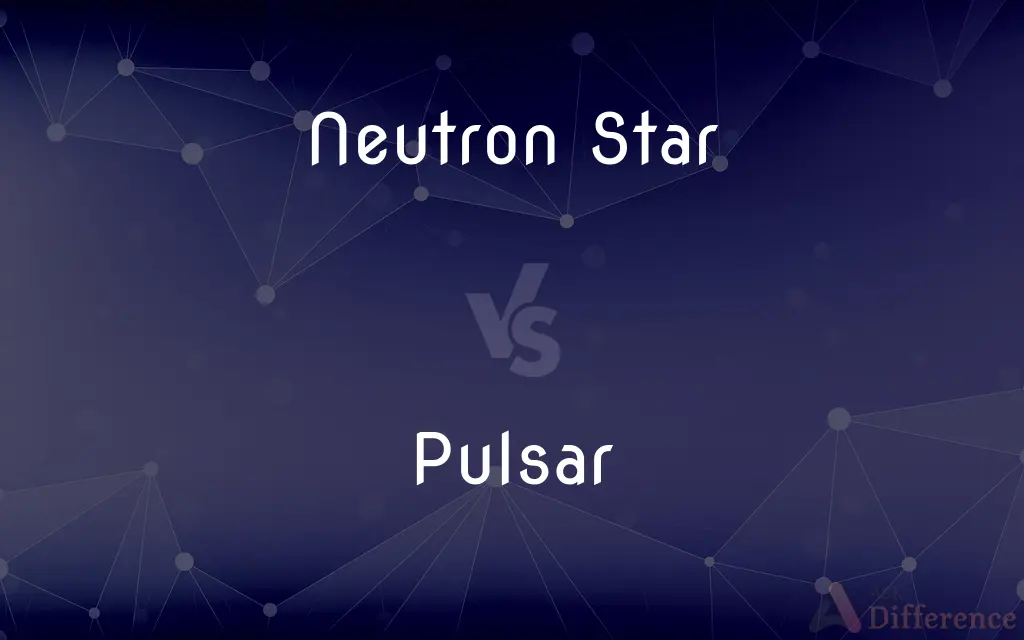Neutron Star vs. Pulsar — What's the Difference?
By Tayyaba Rehman — Published on November 20, 2023
A Neutron Star is the collapsed core of a massive star after a supernova. A Pulsar is a rotating Neutron Star emitting beams of radiation from its poles.

Difference Between Neutron Star and Pulsar
Table of Contents
ADVERTISEMENT
Key Differences
A Neutron Star is the incredibly dense core remnants of a supernova, the explosive death of a massive star. These stars have exhausted their nuclear fuel, leading to a gravitational collapse and an explosion, leaving behind this dense core. On the other hand, a Pulsar is a specific type of Neutron Star.
Pulsars are Neutron Stars that emit beams of radiation out of their magnetic poles. As these stars rotate, the beams sweep across the universe, much like the beam of a lighthouse. If the Earth is in the path of this beam, we can detect pulses of radiation, leading to the name "Pulsar."
It's important to understand that while all Pulsars are Neutron Stars, not all Neutron Stars are Pulsars. This is because not every Neutron Star has the precise conditions, orientation, or characteristics to emit detectable beams of radiation.
A Neutron Star can potentially become a Pulsar under the right conditions. Over time, the emitted radiation from a Pulsar can wane, turning the Pulsar back into a non-pulsing Neutron Star.
In essence, while both Neutron Stars and Pulsars relate to the end stages of star evolution, Pulsars represent a specific, active, and observable subset of Neutron Stars that emit beams of radiation.
ADVERTISEMENT
Comparison Chart
Definition
Dense core remnants of a supernova.
A rotating Neutron Star emitting beams of radiation.
Emission
Does not necessarily emit detectable beams of radiation.
Emits beams of radiation from its poles.
Rotation
Rotates but without detectable beams.
Rotation causes detectable beams, like a cosmic lighthouse.
Universality
All Pulsars are Neutron Stars.
Not all Neutron Stars are Pulsars.
Lifecycle
Can potentially become a Pulsar.
Can revert to a non-pulsing Neutron Star over time.
Compare with Definitions
Neutron Star
A highly compacted remnant of a supernova.
The Neutron Star's density is so immense that a teaspoon of its material would weigh billions of tons.
Pulsar
A rotating Neutron Star emitting beams of electromagnetic radiation.
The Pulsar's beams sweep across the Earth, creating a lighthouse effect in space.
Neutron Star
A celestial body primarily composed of neutrons.
The intense gravity of a Neutron Star crushes protons and electrons together to form neutrons.
Pulsar
A celestial body that emits regular pulses of radiation.
Astronomers detected a Pulsar due to its consistent rhythmic emissions.
Neutron Star
A star with strong gravitational forces due to its compressed state.
The gravitational field around a Neutron Star is so strong that it bends light around it.
Pulsar
The cosmic equivalent of a lighthouse due to its rotating beams.
Mariners have lighthouses for guidance, while astronomers have Pulsars.
Neutron Star
The final evolutionary state of a massive star after a supernova.
Astronomers found a Neutron Star in the center of the Crab Nebula.
Pulsar
A Neutron Star with beams of light emerging from its magnetic poles.
As the Pulsar rotates, its beams of light can be observed from Earth.
Neutron Star
The super-dense leftover core of a massive star's explosion.
The Neutron Star is the stellar corpse that remains after the fireworks of a supernova.
Pulsar
A fast-spinning star that releases detectable beams as it rotates.
The rapid rotation of the Pulsar produces a flashing effect in the night sky.
Pulsar
Any of several celestial objects emitting periodic, short, intense bursts of radio, x-ray, or visible electromagnetic radiation, generally believed to be quickly rotating neutron stars.
Pulsar
(astronomy) A rotating neutron star that emits radio pulses periodically.
Pulsar
A degenerate neutron star; small and extremely dense; rotates very fast and emits regular pulses of polarized radiation
Common Curiosities
How is a Pulsar related to a Neutron Star?
A Pulsar is a specific type of rotating Neutron Star that emits beams of radiation from its poles.
How are Pulsars detected?
Pulsars are detected by the regular pulses of radiation they emit as they rotate.
How long do Pulsars pulse?
The pulsing duration varies, but over time, some Pulsars can stop emitting detectable beams.
What is a Neutron Star?
A Neutron Star is the incredibly dense core remnants of a supernova, the explosive death of a massive star.
How do Pulsars emit beams of radiation?
Pulsars emit beams due to their strong magnetic fields and rapid rotation.
Can a Neutron Star become a Pulsar?
Yes, under the right conditions, a Neutron Star can become a Pulsar.
What causes a star to become a Neutron Star?
A star becomes a Neutron Star after undergoing a supernova explosion, leaving behind the dense core.
Is it possible to see a Neutron Star with the naked eye?
No, due to their small size and often faint emissions, Neutron Stars are not visible to the naked eye.
Are all Neutron Stars Pulsars?
No, while all Pulsars are Neutron Stars, not all Neutron Stars are Pulsars.
Why is a Neutron Star so dense?
A Neutron Star's immense density results from the gravitational collapse of a massive star, crushing protons and electrons into neutrons.
Do Pulsars have a fixed frequency of pulses?
While many Pulsars have a consistent pulse frequency, some can vary or even turn off temporarily.
How massive is a Neutron Star?
A Neutron Star typically has a mass between 1.1 to 3 times that of the Sun but in a radius of about 10 kilometers.
What's the difference between a Pulsar and a Quasar?
A Pulsar is a rotating Neutron Star emitting radiation, while a Quasar is an extremely bright and energetic center of a distant galaxy.
How was the first Pulsar discovered?
The first Pulsar was discovered in 1967 by Jocelyn Bell Burnell and Antony Hewish through radio observations.
Share Your Discovery

Previous Comparison
Social Media vs. Traditional Media
Next Comparison
Ionic Product vs. Solubility ProductAuthor Spotlight
Written by
Tayyaba RehmanTayyaba Rehman is a distinguished writer, currently serving as a primary contributor to askdifference.com. As a researcher in semantics and etymology, Tayyaba's passion for the complexity of languages and their distinctions has found a perfect home on the platform. Tayyaba delves into the intricacies of language, distinguishing between commonly confused words and phrases, thereby providing clarity for readers worldwide.













































